Introduction to the cultivation methods of 6 common hydroponic plants! Easy to maintain and highly ornamental
In recent years, with the continuous improvement of living standards, many friends like to grow some potted plants indoors, which can purify the air, green the environment, and cultivate their temperament. In the process of growing potted plants, many friends like to do hydroponics, which is not only convenient for maintenance, but also has a different ornamental value. So, how to grow hydroponic plants? Here are some common methods of growing hydroponic plants.
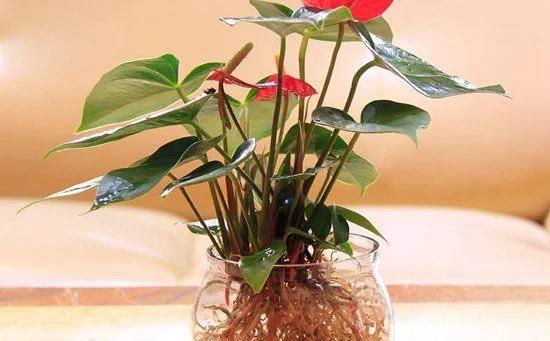
Photo: Hydroponic Anthurium
1. Hydroponic Anthurium cultivation method
1. Transplantation of Anthurium: Dig the potted Anthurium out of the soil, cut off the rotten roots, hairy roots and old leaves, wash the roots with clean water, put them in potassium permanganate solution for disinfection, and then wash the Anthurium with clean water. If you use a transparent glass container to hydroponically cultivate Anthurium, it is best to cover the glass with a black plastic bag to prevent strong light. Cover it with a transparent convenient bag (to keep warm and moisturize). Place it in a place with scattered light and keep the temperature above 10 degrees.
2. Nutrient solution configuration: It is recommended to choose foliage plant nutrient solution, which must be replaced every 7-10 days. Regularly changing the water for the anthurium can remove the mucus secreted by the roots of the anthurium and some algae. In summer, the temperature is high, so water should be changed more frequently than in winter. It is recommended to change the water for the anthurium every 2-3 days. The water should not be filled too full to prevent the roots of the anthurium from rotting. It is best to keep about half of the roots of the anthurium above the water surface. This can ensure the roots absorb oxygen.
3. Light and temperature: Anthurium likes semi-shade, warm and humid environment is also one of the requirements for the growth environment of Anthurium. It is afraid of sunlight exposure. Pay special attention to the placement during the cultivation process. It is best to place it in a ventilated and breathable place that can avoid strong light exposure. In summer, pay attention to the temperature of the surrounding environment for hydroponic Anthurium. The relative air humidity should be maintained at 80%. When the weather is relatively dry, sprinkle some water on the leaves of Anthurium in an appropriate amount. The temperature of hydroponic Anthurium in winter cannot be lower than 14 degrees. Below this temperature, Anthurium is prone to frostbite. Pay attention to keeping it warm. And control the air humidity at around 80%, and be sure not to place Anthurium outdoors, otherwise it is easy to cause frostbite.
4. Reasonable oxygenation: The difficulty faced by hydroponic Anthurium is that low dissolved oxygen in the water will cause root rot. Therefore, the oxygen content in the water should be increased in time during hydroponic cultivation. The easiest way is to vibrate. Fix the flower plant with one hand and hold the container with the other hand and gently shake it more than 10 times. The dissolved oxygen content of the nutrient solution after shaking can be increased by about 30%. Or add 1% hydrogen peroxide (3% hydrogen peroxide) to the nutrient solution. If conditions permit, you can also use a micro submersible pump or an oxygenation pump to oxygenate the nutrient solution.
5. Selective root removal: When cultivating Anthurium hydroponically, you can remove some of the original soil roots and do light root removal. If you want to enhance the root system's ability to adapt to aquatic environments, you can do heavy root removal.
6. Timely water change: The roots of Anthurium have strong respiration. You should change the water regularly, remove the mucus and some algae secreted from the roots, and cut off the old and rotten roots. This also helps to increase the dissolved oxygen in the water. Generally, the water should be changed every 2 or 3 days. In winter, it can be changed once a week, and nutrient solution should be added every time the water is changed. When hydroponically cultivating Anthurium, only 1/2 of the roots of Anthurium should be immersed in water, and the rest of the roots should be exposed to the air so that the roots of Anthurium can breathe. Insufficient dissolved oxygen in the water will cause the roots of Anthurium to rot.
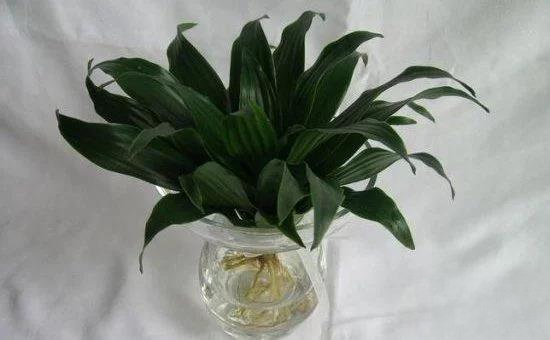
Figure: Hydroponic Aspidistra
2. The cultivation method of hydroponic Aspidistra
1. Choose utensils: According to the species, shape, specifications, and color of the Aspidistra, choose substitute bottles, pots, jars and other utensils that can complement the Aspidistra species. Purchase or make them yourself according to the principles of selecting hydroponic utensils, so that they can be used appropriately and look elegant. Do not take the utensils casually or use them at will, so as not to affect the image of the hydroponic Aspidistra and the beauty of the interior decoration. Make the utensils, flowers and living environment unified and harmonious to achieve a more ideal viewing effect.
2. Remove soil and wash roots: Soil cultivation is organic nutrition, but after changing to hydroponics, it is completely changed to inorganic nutrition cultivation. The organic matter in the soil and attached to the root system must be strictly cleaned to avoid affecting the normal growth of hydroponic Aspidistra and the infection of pests and diseases. The method of root washing is to dig the selected flower plants out of the soil or gently pour them out of the flowerpot. First, use your right hand to gently lift the branches and stems, and your left hand to gently support the roots. Then use your right hand to gently shake and pat slowly to make the soil at the roots fall off and expose all the roots. Then soak in clean water for 15-20 minutes, and then gently wash the roots with your hands. After 2-3 changes of water, wash until the roots are completely free of soil. The water for washing the roots is clear and transparent without mud and sand. It is necessary to leave no soil at all. This is one of the important links for the success of hydroponics and must not be neglected.
3. Cut off old roots: After washing the soil off the Aspidistra, you can cut off old roots, diseased roots, old and yellow leaves according to the growth of the root system of the flower. Because the roots of the hydroponic Aspidistra are also an important part of the ornamental, the beauty of its shape should also be considered when arranging the root system. After trimming the roots and leaves, wash them again in clean water to rinse off the root hair residue left when cutting, so as to avoid bringing them into the hydroponic equipment and causing pollution.
4. Root disinfection: After cleaning the roots of Aspidistra, prepare a 0.1% potassium permanganate solution and place it in a plastic or enamel basin. The amount of solution can be determined according to the number of Aspidistra to be soaked. Several or more Aspidistra can be soaked at a time, with the standard of submerging all the roots. After soaking for 10-15 minutes, take the Aspidistra out of the solution, wash it in clean water and plant it. Note that the root disinfection time should not be too long or too short, and the potassium permanganate solution should not be too concentrated or too dilute. In addition to using a balance, the appropriate ratio is mainly determined by experience and the color of the solution (light purple-red).
5. Scientific planting: If it is a glass vase, because the glass is thick and has a certain weight, you can straighten the roots of the Aspidistra and carefully put it into the vase. In order to prevent the Aspidistra from standing upright, you can fix the mouth of the bottle with stones or pebbles, and then pour 2/3 of water into the bottle. Pay attention to stretching the roots. If you use a plastic vase, because it is very light, it is difficult to support the Aspidistra plant even with water, causing it to be top-heavy and fall over. Therefore, before planting such utensils, you can first put a certain amount of stones in the bottle to increase the weight of the vase, and then plant the Aspidistra in the vase as before. If you use other kinds of flower pots without bottom holes or round and long fish tanks to plant hydroponic flowers, you must consider the problem of root fixation in the water.
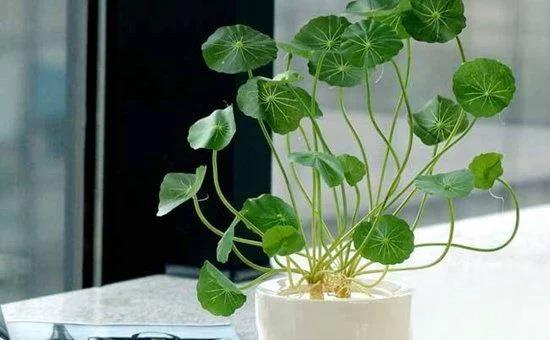
Figure: Hydroponic coin grass
3. Cultivation method of hydroponic copper coin grass
1. Water quality: The water quality requirements of pennywort for hydroponics are not high. As long as it does not stink or get infested with insects, ordinary tap water can be used for hydroponics. In summer, change the water about every 3-4 days, and change half of the water basin each time. In winter, change the water once a week, and change one-third each time.
2. Temperature: The copper coin grass is suitable for production in most humid and hot areas in the south, especially in summer, where it reproduces very quickly. Its normal growth temperature is most suitable between 10-26 degrees Celsius. Overheating or overcooling will inhibit the growth of copper coin grass.
3. Light: The pennywort likes sunlight very much when growing, so it is best to place the basin outdoors or near a window where there is sufficient light. If it is cultivated indoors, the sunlight exposure time should be no less than 4-5 hours a day. In addition, ultraviolet light or strong fluorescent light can be used instead of sunlight for illumination.
4. Fertilization: The copper coin grass can produce the nutrients it needs for growth through its own photosynthesis, so less fertilizer is needed. If fertilizer is needed, you can dissolve ordinary chemical fertilizer in a basin and let it absorb it by itself, but be careful not to make the amount too concentrated, just a small amount will do.
5. Pests: Pennywort is generally not susceptible to pests, but mollusks such as water snails may gnaw on the grass roots and tender shoots. If such insects are found in the water, they should be removed manually to prevent them from multiplying in large numbers.
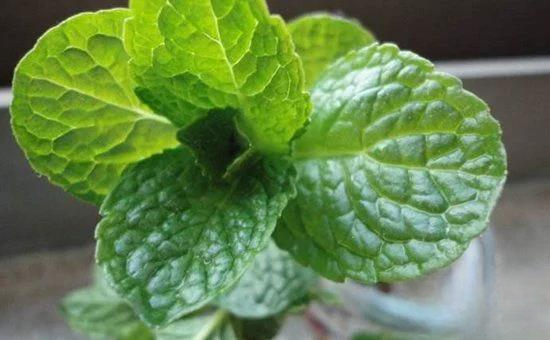
Photo: Hydroponic mint
4. Cultivation method of hydroponic mint
1. Plenty of sunlight: Mint has high demands for sunlight and water, so it should be placed in a place with sufficient light. Placing it in a shaded place with weak light for a long time is not conducive to the normal photosynthesis of the plant, the growth of leaves, and the number of roots will also decrease. Placing the bottle of hydroponic mint in a well-lit place once every two days can meet the light required for its growth.
2. Change the water in time: You don’t need to change the water too often, usually once a week. If the base water in the bottle is reduced, you can add water appropriately, but don’t fill it too full. At the same time, you can add an appropriate amount of nutrient solution to the water to ensure that the nutrients needed for the growth of mint are sufficient.
3. Watering for moisturizing: Although mint is hydroponically grown, it is still necessary to water the leaves for moisturizing, usually twice a day. Use a small spray bottle and do not spray too much water. Mist water is easier for the leaves to absorb.
4. Notes: If the leaves turn black during the hydroponic process, remove them in time. For herbs, you don’t need to worry about removing leaves. On the contrary, the more you remove, the more prosperous they will be. When changing the base water, clean the roots and remove the rotten leaves in the water to ensure the cleanliness and health of the base water and plants. Whether hydroponics or soil cultivation is used, mint grows very quickly, so you can branch the mother plant, that is, pinch off one branch and divide it into two branches to continue hydroponics or soil cultivation.
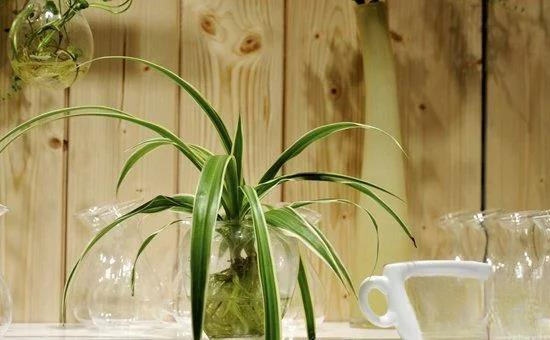
Figure: Hydroponic Chlorophytum
5. Cultivation method of hydroponic spider plant
1. Sufficient water: Hydroponic spider plants do not need watering, but the water must be changed frequently. Especially in summer, the water needs to be changed to cool the plants. Usually change the water every 3-4 days, and sprinkle more water around the plants at noon to ensure moist air.
2. Moderate light: Chlorophytum is a shade-loving plant, but it also needs light. Do not expose the Chlorophytum directly to the sun in summer. You can put it on the windowsill and shade it appropriately. If the Chlorophytum is exposed to the sun, the leaves will turn yellow and lose their luster.
3. Proper fertilization: Most hydroponic spider plants are soaked in nutrient solution and require less fertilizer, but they still need it. Every time you change the water, you can sprinkle a few grains of nitrogen fertilizer into the water, preferably in granular form.
4. Change the culture solution: Add water and replace the nutrient solution of the hydroponic spider plant every 7 days or so. It can be a common hydroponic nutrient solution on the market or a special nutrient solution. Pay attention to replace it in time to keep the water clean. If necessary, clean the roots of the spider plant when changing the nutrient solution.

Picture: Hydroponic dripping angel
6. Cultivation method of hydroponic weeping angel
1. When changing soil-grown plants to hydroponic plants, be careful when washing the roots, and try not to damage the tubers and roots. At the same time, cut off the rotten roots and aging roots. If the tubers have no roots, place them in a shaded place to dry for 2-3 days, and then immerse them in water after the wounds are dry. New roots will be seen after 2-3 days.
2. Pay attention to the fact that water should be changed every 2-3 days in the early stage of hydroponics, and the water depth should be such that 2/3 of the root system is submerged. New roots will grow after a week. After 3 weeks, when the hydroponic plants have adapted to the hydroponic environment, they can be cultured with nutrient solution. After that, the nutrient solution should be changed about once a month.
3. Since the stem tissue of the weeping angel is relatively loose, it is easy to be polluted if the water quality is poor, causing root rot and stem rot. Therefore, keep the bottle water clean, and at the same time, you should also change the water or the back nutrient solution to clean the mucus on the tubers and roots, and cut off the rotten roots.
4. In hot summer, the frequency of water changes should be increased, and the air humidity should not be less than 60%. Spray water frequently to create a relatively cool and humid environment. In winter, the leaves should be kept dark green, and warm water should be sprayed once a week in general.
5. The water level should be above 2/3 of the root system. Clean the inner wall of the container frequently to prevent moss growth.
6. The juice in the stems and leaves of the weeping angel is poisonous. Care should be taken during maintenance and management. It is not to be ingested. It will cause itching and redness on the skin. It should be rinsed with water in time, or it is safer to wear plastic gloves when operating.
[Editor's Conclusion] Chlorophytum, mint, anthurium, etc. are all common potted plants in daily life, which are very suitable for hydroponics. The above article introduces the cultivation methods of 6 common hydroponic plants, I hope it can help you!